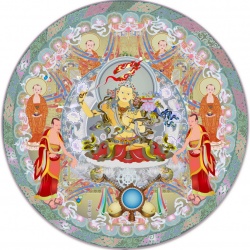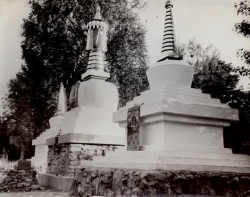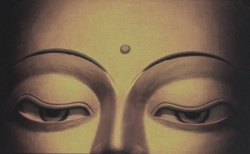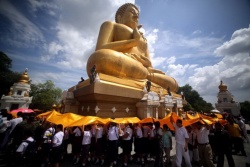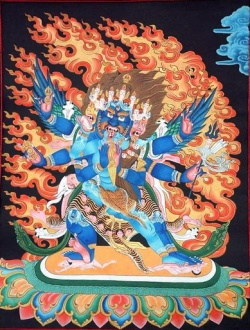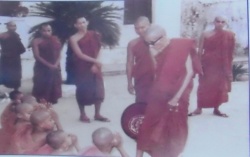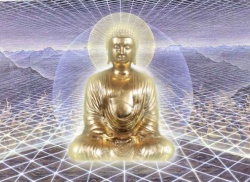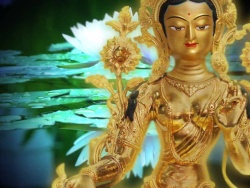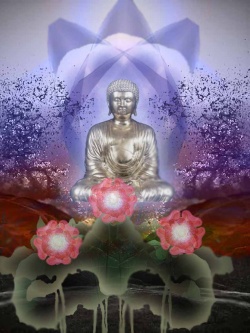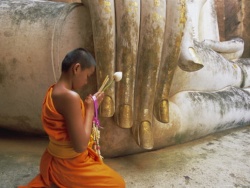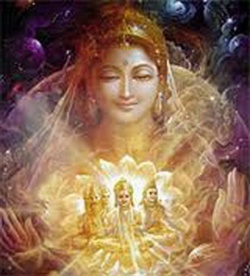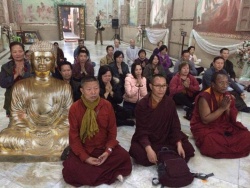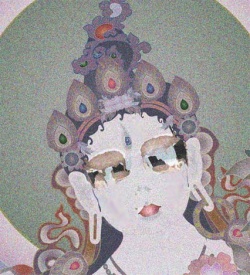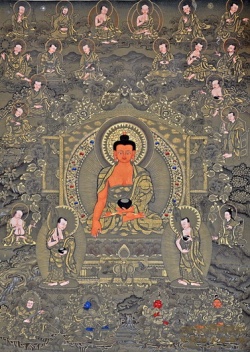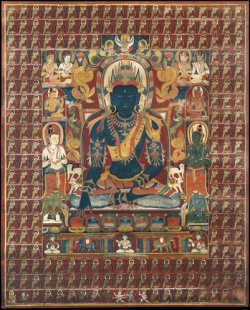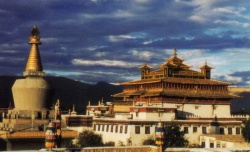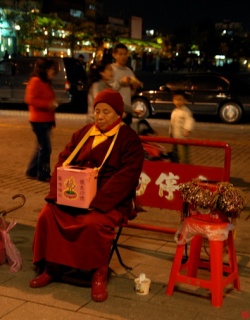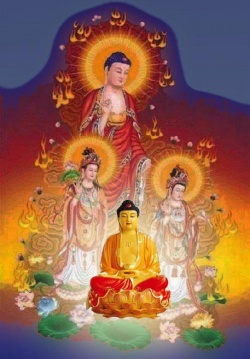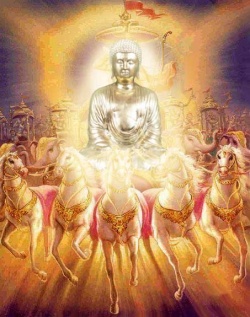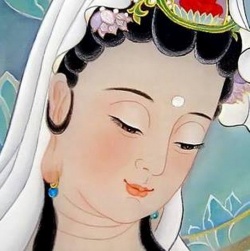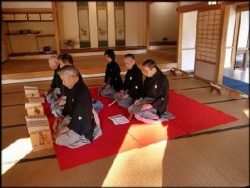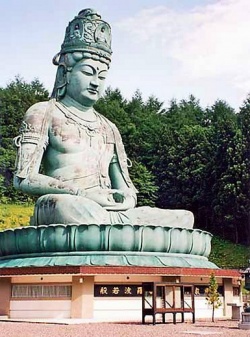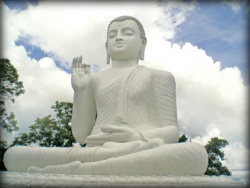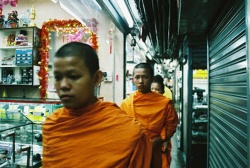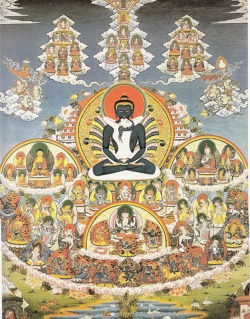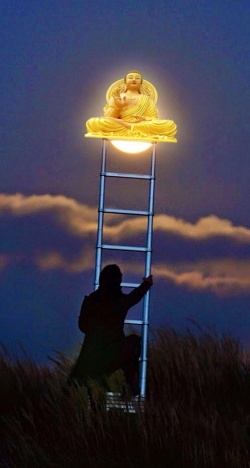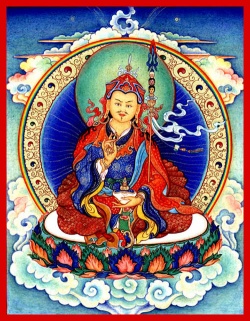Tibetan Debate, a Dialectic Process of Disputation
Development of Buddhist logic
The science of logic spread rapidly in India.
By the time of the Buddha it was considerably developed and had also become complex.
But the Buddha, who revolutionized all the knowledge, changed the tone of logic from its former empirical nature (Vyavaharika-prakti) to being a subject of spiritual knowledge (Adhyatma Vidya).
Buddha did not argue for the absolute validity of his words.
He did not recognize scripture (agama) to be valid logic (pramana) but encouraged the process of reasoning and debate by which the truth was to be known or discovered.
For this reason his followers acquired a formidable self confidence and developed an unsubmissive self reliance.
Thus, one scarcely finds Buddha’s own words in the sutras.
Most of the Buddha-Discourse consists of dialectical argumentation between enlightened disciples. One who attempts to find a final judgment will not find it, for Buddha advances arguments only to lead to further seeking.
Buddha’s idea was to avail his disciples of the fullest opportunity to develop their minds and discover the truth in a free atmosphere.
This caused logic to become spiritual and not to remain confined to limit knowledge or skill in world of illusion.
The system of logic, which Buddha made possible, was not an exclusive method acceptable only to his disciples, but rather a refined manner of dialectic debate. This method, presented on the sutras of Pali Tripitaka and in the Mahayana Sutra, gave a new dimension to the use of syllogisms and the science of reasoning.
It may appear surprising to many that there is no evidence of an exclusively Buddhism system of logic in primitive Buddhism.
It was only after the great decease (Mahaparinirvana) of Lord Buddha that the arguments used in Buddha’s parable were systematized into the logic meant for public disputations.
This view is repudiated by some scholars who think that there was some kind of manual of formulatory digest for debate in Buddha’s time.
However, the absence of such a manual is obvious.
At some stage after the Buddha’s Parinirvana the Buddhist canon incorporated the teachings of logic enunciated by Gautama.
The post Dignaga logicians derive the three classes of logical reasons from the Buddha- Discourses.
Nagarjuna, with whom Mahayana became a substantial philosophy, was an extraordinary dialectician.
But a study of his Madhayamika world would clearly justify the statement that he did not adopt the dialectical method of the Naiyayika system.
It is also apparent from his works, especially his Vaidalya-Sutra that he knew the dialectical system of the Naiyayika and it has been claimed by scholars that he employed many technical terms of Naiyayika logic in his Madhyamikakarikas and other treatises.
There is however no evidence of any Buddhist work of logic prior to or contemporaneous with Nagarjuna.
It is nevertheless undeniable that an uncommon dialectical system had been developed by pre- Nagarjuna Buddhist scholars who applied it in their science of reasoning.
Buddhist logic was systematized by Dignaga (c.AD.450-520). He has been termed the father if Buddhist Pramanasatra and the father of medieval logic.
Although it cannot be ruled out that there were other logical works and theories of syllogism, which existed before his time.
For example, Maitreyanatha discussed several points bearing on logical in his five famous works (Byams-chos-sde-lnga).
There is also a separate chapter on the art of debate (Vadavidhi) inserted in his composition called the Saptadasa-Bhumisastra-Yogacara (extant in Chinese translation).
This chapter has seven sections.
1. Subject of debate
2. Place of debate
3. Means of debate
4. Qualifications of debater
5. Point of debate
6. Attendance in a place of debate
7. Confidence of a debater.
Arya Asanga also extensively drew on the subject of Pramana in his Bodhisattava-bhumi, but his conception of the science of reasoning (hetu-vidya) is very much different from Dignaga’s school.
Asanga accepted five groups of reasoning which were catergorically denied by Dignaga.
According to the tibetan tradition, Asanga is the earlist Buddhist author to deal exclusively with theory of reasoning and syllogism, similarly, two more works of the same period as that of Asanga, the Vadavidhi and Vadavidhana (assigned to Vasubandhu and found in incomplete translation in Chinese ) treat this subject.
There is doubt about the authorship of these two works since Dignaga clearly state in his Pramana-Samucchaya that Vadavidhi is not Vasubandhu’s composition.
Dignaga really formulated the Buddhist logic into a complete spiritual science ( adhyatmavidya)and a pramana, or science of reasoning and correct knowledge. His system of logic paved the way for Buddhist philosophy and metaphysicks.
The study of dialectic methods of reasoning disputation, which was an efficatious method of teaching.
That the practicing, memorizing, analyzing, and examining a subject. It is also a valid testing method for examining the inward sciences.
Development of Logic in Tibet
The Pramana-Sastras of the Buddhists quickly spread and flourished in Tibet.
The credit of this goes to such venerable Acaryas as Santaraksita and his chief disciple Kamalasila.
Both of them were renowned scholars of Pramana, respectively composing the famous treaties Pramana Tattva-Samgraha and its commentaries.
Although these text and commentaries are not mainly concerned with logic, still they are considered great inter disciplinary works of Pramana which the Tibetans term the ‘Mahapramana’ (Tsad-chen).
The people of our country witnessed the famous and interesting public debate which took place between Kamalasila and the Chinese Hoshang, on the subject of Madhayamika, during the reign of Thrisrong Detsen (khri srong ide btsan) in the later half of the eighth century A.D.
The impact of this debate must have been enormous on the minds of the immature Tibetan people, as they become acquainted with the Buddhist’s doctrines for the first time in that admirable way.
It is not possible to write a systematic account of the study of logic in Tibet before the eleventh century, for there exists no trustworthy record to account for Pramana at that time.
The translation of Dharmakirti’s works into Tibetan were carried out at a much later date.
The Denkar catalogue includes only the titles of treatises, which belong to Dignaga.
During the first phase of classification and cataloguing of the translated scriptures done at Denkar palace, there were only twenty five titles of works of logic which included small tracts of Dignaga and Dharmakirti.
Such comprehensive works as the Pramana samucchaya, Pramana vartika and Pramanaviniscaya remained untranslated at that time.
The translations of the major works of Dignaga and Dharmakirti were completed so late that it is difficult to hazard an opinion about the systematization of the study of Buddhist Pramana as it was taken up by all the monasteries, in accordance with their programs of study.
The lineage of Buddhist logicians, written by Gowo Rabjampa Sonam Senge, mentions that Sakya Pandita directly inherited the study of logic from Indian Acaryas such as Danasila, Sanghasri and others.
However, even from Sakya Pandita a few other scholars has composed works on logic.
Some scholars have recently noted that Choekyi Senge, also known as Rigpay Wangchug Chapa (A.D 1109-1169), was first author to write an independent work on logic.
Until more evidence substantiating this is found, we may tentatively place reliance on this information.
It is widely accepted that the Tibetan dialectical debates were systematized by Chapa Choekyi Senge.
I cannot myself speak on this matter as I have not read an authentic biography of Chapa Choekyi Senge.
However, several learned men have reffered to Chapa Choekyi Senge and Tsangnagpa, both scholars of Sakya tradition, as ‘senge namnyi’ (seng-ge-rnam-gnyis, two genius lions) and evidently look on them with reverential awe.
Their works were followed by the erudite by the erudite treaties of Kunga Gayltsen Pal Sangpo (Sakya Pandita) who pioneered the study of logic in Tibet.
His work Tshed-ma rig-ter (tshad ma rig gter, Pramanayuktinidhi), comprised of a basis text and its commentary, has received wide acclaim.
There is a belief that this work was also translated into Sanskrit; possibly the first and only Tibetan work ever to be translated into Sanskrit.
It was admired by Indian scholars. Anyone studying this great work would see the justification of Sakya Pandita’s boast ‘ I am the logician’ in his ‘Eight I’s’ (nga brgyad ma).
It was he who for the first time compiled the entire works of Dignaga, Dharmakirti and their commendation in a systematic way.
The validity and utility of logic as a subject cannot be denied. Not only the text of the Perfection Vehicle, but also all the Diamond Vehicle works have adopted the technical terms of logic and syllogism.
The four principal philosophical sects of Tibet have included logic in their courses of study and have written nemurous books on the subject.
In fact, the foundation of logic in Tibet should be assigned to the pre Tsongkhapa period, i.e, the age of Sakya Pandita.
Modern scholars of Buddhist logic correctly devided the history of Tibetan logic into two periods.
The old-up to time of Tsongkhapa (A.D 1357-1419) and the new-after Tsongkhapa’s time.
Tsongkhapa did not himself compose major treatises of logic.
But, his chief disciples, notably Gyaltsen Je, Khedrup Je, Gedun Drup and some others dwelt extensively on the subject, and made the Gelugpa order famous for scholarship in logic.
Because Pramana was well established in the Sakya sect. Tsongkhapa received his teachings of Pramana from scholars of that sect, namely Redawa Shonnu Lodow and Lama Lotsawa Dhunsangpa.
Since the eleventh century A.D. there have been few scholars who have not written commentaries of glosses on the Pramana sastra.
This sastra has been taken to be an indispensable part of Buddhist Studies.
There is a widespread misconception that the votaries of the Nyingmapas and Kargyudpa sects did not care for the study of logic, or think its study necessary for the realization of truth.
However this is not the case. Many kargyudpa scholars took to studies of pramana and subsequently continuously contributed to its growth.
Among them the seventh Karamapa, Chodag Gyatso, Dagpo Rabjampa, and the eight Zhamarpa.
Kunkhyen Pekarwa, were outstanding logicians whose contributions to the subject are greatly appreciated.
It is true that one hardly finds a comprehensive treatise on logic annotated by scholars of the Nyingmapa scholars such contributors to Pramana as Surchen.
Sakya Juknay and his followers stressed the study of this subject.
The subject of Pramanasamuccaya and the Pramana Viniscaya texts were especially prescribed in this order.
It is not definitely known if Kunkhyen Longchen Rabjampa (1308-1363), the most prominent scholar of the Nyingmapa sect, wrote a commentary on Pramana works.
His collected works, which includes many texts, does not contain writing on logic; but his scholarship of logic is undisputed.
His works abound in well-ordered dialectic disputations and syllogistic sequences, showing his great skill in logic. Of course, he had been a brilliant student of Sangpu monastery, an important seat of the study of logic in Tibet.
Therefore, it is surprising that being a product of this great institution he did not write on logic.
Recently I have been told by some Nyingmapa friends that the venerable Polo Khenpo came across in Kongpo, a great commentary on the Pramanavartika said to have been written by Longchen Rabjampa.
The Polo Khenpo had been travelling in the Kongpo valley in 1957 or 1958 when he saw this treatise.
This occurrence seems to me factual. In any case, Lonchen Rabjampa ‘s writings on Pramana are not available.
Ju Mipham kep alive the Pramana tradition in the Nyingmapa order by writing his very erudite commentary on the Pramanavartika.
The existence of this commentary repudiates any misconception about the tradition of logic in the Nyingmapa order.
The famous monastic institutions of that order such as Kathog, Shichen and Palpung have included Pramana in their courses of study.
With little variations, the Pramana sastra has been studied by all sects of Tibetan Buddhism.
The public debate system as adopted by the Sakyapa and Gelugpa sects is another matter.
It has not been popular with the followers of the Kagyudpa and Nyingmapa sects.
The direction of enquiry into the validity of knowledge also varies among the two sects of enquries.
Those of the Sakya-Gelug tradition and those of the Nyingma-Kargyud tradition.
This brief account of development of study of the Pramana sastra in connection with an inquiry into the public debate system of Tibet will shed light on the role of logic in classical disputation.
From this discussion it will become evident that, unlike the western science of logic which is based on reasoning, Buddhist logic validates correct knowledge (Pramana Tib tsad-ma) and the science of reasoning (hetu;Tib.rtags).
The word ‘logic’ in common conversation stands for hetu-vidya but it hardly connotes pramana.
Codes of dialectical debates and of public debate are incorporated in the hetu-vidhya part of the Pramana sastra debate as practiced in the monasteries of Tibet is a product of ‘applied logic’ and the science of reasoning.
The Development of Public Debate in the Buddhist Order
The science of public debate (Sastrartha) and its councils are mentioned in the Upanishads, the system has been known in India from an early period.
In the time of Buddha such vada councils had become well established, and debates used to take place among the learned in a spiritual atmosphere.
Buddha has been shown in council with the sangha, debating with his disciple and expounding the true laws.
His tarkik position in debating with the Brahmans is too firm to yield to their arguments and he finds fault with their syllogism.
With the evolution of the Mahayana in India and its rapid growth, the practice of debate became indispensable in the life of the scholars of Buddhist monastic institution from AD 400 to AD 1200.
This system preserved true knowledge in the monasteries by sharpening the minds of scholars in reasoning and allowing them to write commentaries on philosophical texts.
It simultaneously safeguarded their institutions against hostile or combatant scholars coming from outside (phyi-rolpa) with a view to defeat them and establishes their own supremacy.
History has records of such debates and sometimes legendary accounts of these were also widespread.
The life of Buddhist scholars is considered to be devoted to three solemn purposes,
1.Preaching (‘chad-pa)
2.Debating (rtsod pa) and
3. Composing (rtsam pa).
Hence he must be dedicated to self development for the sake of dissemination of the true doctorine.
Comprehensive rules and codes of discipline have been laid in Buddhist works for observation and practice by all scholars who are engaged in the spiritual field and who view the growth of knowledge and morality as essential to the purification of life.
The importance of debating (rtsod pa) is apparent in the threefold formula for the purposeful life of a Buddhist scholar, and justifies the excellence of the Buddhist in taking up points of arguments in debates and enunciating the laws given by the Buddha; in the way they have been admirably laid down in the scriptures and have shown the path of deliverance.
As mentioned, Maitreyanatha’s text appears to be the earliest Buddhist work on the subjects of debate.
Asanga, too, dealt with the subject in many places in his famous treatise of the five Bhumis (Sa-sde-Inga).
The Vadavidhi and the Vadavidhana, to whom their works may really belong to, are also of pre-Dignaga school on public debate.
But they did not establish a separate school of Buddhist debate, as the Naiyayikas would include them in their own system.
For a clearly defined Buddhist school of dialectics which is clearly separate from the other schools of Nyaya pravelent in the olden days, we must refer to Dignaga himself who repudiated 24 paradoxical points in the Naiyayika system.
Later Dharmakirti denied 22 points of logical defeats, thereby establishing an unparallel method of disputations.
An exclusive treatise was written by Dharmakirti known as Vadanyayanama-prakarana (rTsod pa’I rigs pa) which mainly treats the dialectical process in logical argumentation.
We can take this to be a milestone in the specialized system of disputation.
In it one finds a well-substantiated, comprehensive and full treatment of the subject, although in making one fully conversant with its full import, it is not without complications.
This discipline of debate prescribes the qualification of debaters, as also for the judges who are supposed to be competent authorities on this system.the discipline undertakes to define the subject of debate, ways of disputation, order of syllogisms, as well as motivation for debate and the general code of conduct while the debate is being carried out.
It is not only the particular order of syllogisms or the specific qualifications of the debater which has made Buddhist debate unique, but also the motivation for debate and the code conduct of debater have really distinguished it from any other forms of disputation.
While laying down the principles of motivation and conduct, it was well mentioned that the tone of debate should not be such as to elicit pride or exaggerated wisdom in the debater.
For this reason the demonstration of unqualified humour and sense of petty pleasures is to be avoided as far as possible and due regard is to be given the debater’s age and learning keeping in mind the use of refined language and expression of address, Candrakirti, in his Madhyamakavatara, teaches that analysis in treatise is not for the sake of debate, but it is meant for attainment of liberation (vimukti).
It might be asked whether the act of repudiating the treatises of others itself is not a matter of offence?
The answer is no. In fact, if the examiner has neither attachment to his own conceptions nor hatred towards others, views he is likely to be liberated soon.
In view of the importance of such disputation, the early scholars and sages of Tibet not only adopted the entire system of Buddhist dialectical debate, which was in vogue in the Mahaviharas of Nalanda, Vikramasila and Odantapuri, but they developed is considerably, sometimes in accordance with their own uncommon methods and even added far greater importance to the subject.
The Uncommon System of Tibetan Traditional Debate
A tradition was evolved in Tibet to begin philosophical studies with logic and a condensed manual of logic, called (bsdus gra), was composed.
Key proposition and reasoning are considered to be necessary elements of philosophical enquiry. So far no manual of condensed logic resembling the Tibetan dus-da (bsdus-gra) has been found in India.
In Tibet, the study of logic is commonly accepted as a means for understanding recondite subjects.
It is a matter of admiration that the early teachers in Tibet, endowed with critical perception, introduced this method of logic into general metaphysical enquiry. The vocabulary and the technical terms used in debates are also worthy of note.
When accompanied by physical gestures and exclamations they highlight the wide communicability which is the intended purpose of the Tibetan debater.
It is commonly held that the wide use of physical gestures in disputation ws invented by Chapa Choskyi Senge.
Before him there had been no such physical activity prescribed for dispute on metaphysical subjects either in Tibet or India.
Physical performance added colour and is source of joy to the audience.
Simple clapping of hands seems to have been practiced everywhere in disputations, but in Tibet such physical actions were performed in a standardized way.
Those who are conversant with the methods of Sastratha in an Indian philosophical council know very well that at the height of one’s debating performance the disputant often becomes vociferous and aggressive due to strained emotions.
A verse of Acarya Vadasimha (sMra va’I senge) cited by Sakya Pandita in his commentary, the Eight I’s says: “Although I announce this assertion by raising both my hands, I find non coming forward to refuse it”.
This again shows a physical expression raising the hands.
They system of Chapa Choskyi Senge enjoins a process in which the questioner (snga rgol) has to stand up and keep moving as the debate is in progress in that he has to turn around after posing his question.
Each sentence of the question isi followed by a vigorous clapping which produces a loud sound rhythmically articulated by firmly placing the left foot on the ground. There upon he puts down his left hand and with his right hand draws up his rosary.
The rosary, which remains hanging on his left arm, moves from the level of his waist up to his left upper-arm.
Listening to the answer he moves slowly, with pause.
After he receives a reply to his question, he becomes ready to pose a counter –question or repudiation.
The physical actions of the repudiater, who is seated, are identical with the questioners actions.
In order to present a brighter view of his agility of mind, the monk or debater wraps his upper garment (zen) around his waist while debating.
The answerer (phyi rgol) sits on the floor or on an elevated seat.
He puts on his hat at the time of answering. In the event that in making a point of discussion the questioner quotes some scriptures or treatises in support of this point, the answer takes off his hat as a gesture of reverence to the next quoted and the author who has been cited.
Except for some movements of the hand or fingers the answerer sits still, in rapt attention. As the argument warms up, the parties raise their voices and as they speak more rapidly and become more eloquent, the claps and foot stamping become more raucous.
There are technical words of argumentation to keep the process of enquiry and its satisfaction consistent.
These terms are precise, although cryptic in order to shorten speech. Ambiguity of expression or circumlocution is to be strictly avoided.
The questioner appends one of four specific words to each sentence, classifying his question into one of following four categories”
I. Consequences (thal)- “it follows that”
II. Showing a reason (phyir)- “ because of”
III. Demanding a reason (ste)
IV. Subject ( chos can)- “the subject”
Answers are also suffixed similarly with four technical terms:
I. Affirmation (dod)- “ I accept that”
II. Incorrect reason (rtags ma grub)- “ The reason is not established”
III. The thesis not following from the reason (Khyab pa ma byung)- “non-pervasion”
IV. Demanding a reason for the thesis (ci’i phyir)- “why?”
As is obvious, this second group of technical words, used in the course of a reply, carries an assurance that the question must be answered in a befitting manner in the light of the demanded explanation.
This process of argumentation allows the debate to proceed speedly.
Beginning with the obeisance to Arya Manjusri, the deity of wisdom in the form of a few words given out with a loud call, “Dhi-ji-tar-chhos-can” (Dhi being the seed mantra of the diety), the debate keeps the audience spell bound throughout.
In monasteries, debate are practiced, as outlined above, by the monks.
They assemble in classes and debate together in as many groups of questioner and answer as the assembly permits.
It may seem to the outsider somewhat incongrous that during class debate of this nature sometimes the monks themselves are the contestants and the judges.
More frequently, the whole class sits together in judgment on the performance of the debater.
Sometime a few interruption occur in support of the arguments put forward by the questioner and he has then to explain them more than once, thus stimulating the debate.
These debates are liked so much by scholars that sometimes the whole faculty may be seen witnessing a debating performance which, starting from the modest attempt, has taken a profound turn.
The debates are usually performed in the presence of the Abbot who gives verdicts on scripture and helps in the critical examination of metaphysical problems. Debate contests are also a feature of academic symposium in the monastic organization.
Such contents are called tsog-lang (tshogs lang, standing in the assembly).
In such events the contestants discuss while remaining standing and move with the flow of the discussion.
Different monastic colleges (dratsangs) send their contestants to the assemblies of monks of various other faculties.
The Importance and Benefits of Debate
The system of debate as it become popular in Tibet has had a tremendous influence in shaping the monastic students intellectual caliber, besides giving them a physical mode of expression.
Argumentation has shaped their eloquence and set their vocal and physical frame-work in a harmony seldom achieved in other educational systems, where mind, body and speech are rarely co-ordinate.
Debates are conductive to monks health in a far greater measure than could be provided by sufficient nutrition and the best care of the body.
It is doubtful if the same kind of composed attitude of mind or poise could be achieved by physical or artificial aids.
Through debating monks keep themselves fully alive and jubilant and even the novices and young monks seem to scoff at misery and any amount of hardships in their lives.
The unwary may be astonished to see them always smiling and casually laughing aloud, though seemingly without sufficient reason, laughter opens their hearts and keeps them blooming.
The monks who have learnt and practiced the art of disputation are not subject to the common tensions which afflict most men in modern society.
Without weariness they take up vigorous and intensive study, sometimes without breaks and vacations for a considerable which the monks learn from their associates and in keeping to the transmitted wisdom of their preceptors.
During the debating hours new
information is assimilated and uncommon ideas crop up.
Apart from the common understanding which is developed through debate, deep philosophical inquires may be satisfactorily answered by a competent debater.
In addition to this, old lessons are revised and the contestants develop an enormous power of concentration of the mind. Concentration is the most important thing necessary practice of meditation.
A skillful debater can concentrate a point undisturbed in the midst of any amount of confusion and disorder.
Concentration allows the mind to comprehend without obscuration and to bring forth clear and sharp judgement.
It is possible to contemplate on the most difficult mysteries which cannot be reflected upon in the course of any other pragmatic training.
So far as the knowledge acquired through discussion in debate is concerned, it is very deep and free from civil. It is a fine way of developing a person’s understanding.
In Tibetan monastic institutions all kinds of examinations of candidates are held using the debating method.
This may point to reform in the modern system of examination in which the candidates are only too often reported to have adopted unfair means to show their wisdom.
This is not wisdom, but rather craft.
A person’s real ability, his power of grasping the depth of meaning of a subject can be gauged at once as he stands speaking on a subject.
Retention in memory also goes a long way towards endowing a man with the power of knowledge and his capacity to expound something.
The mechanism of human expression has four levels: physical, intellectual, emotional and spiritual.
I have no hesitation in subscribing to the idea that the traditional Tibetan method of dialectical disputation is the most powerful form of human expression in which the four levels of human expression are harmoniously blended.
I have, yet, to find out any other form of expression or communication similar to this.
Misgivings
Some misgivings about the dialectical process of disputation should be cleared away. One common notion is that the method is futile and only a manifestation of the complex mind of the academician who is far from spiritual realization of life’s reality.
People who subscribe to this view generally consider that debate has no power in realization of truth, but is rather a hindrance to the development of meditation and spiritual progress.
This is not a misgiving; it also existed in olden days. In repudiation of this idea, the logician Dharmakirti wrote his manual of debate (Vadanyaya-prakarana).
In the beginning of this work he says, “to eradicate the ignorance which prevents the ordinary person from realizing the truth, I am preparing this manual of dialectical debate which has been traditionally transmitted from ancient teachers for the great benefit of the sentient beings.”
Kamalasila had a public disputation in Tibet with the Chinese master Hoshang.
Hoshang contended that no conceptualization should be used in the course of meditation and that every thought must be fenced off.
He said that thought voidness is the instantaneous mode of realizing the truth, and that the highest form of meditation is to eliminate the response of the mind to external objects.
A rebutta came from Kamalasila propounding acquisition of wisdom by means of analysis and argumentation within oneself for any substantial inward communication.
This point stresses the importance of syllogism for the understanding of truth. Three remarkable treatises, the three stages of meditation (sgom rim-gsum), were written by Kamalasila to profound his system.
This was regarded as a great contribution to Mahayana studies. I will summarize them briefly for those interested.
The ultimate aim of a follower if Mahayana is the realization of Buddhahood.
The nature of Buddhahood is inseparable from transcendental wisdom (shes rab) and transcendental compassion (rnying rje chen po).
Transcendental wisdom is the most important element and is developed from the combined practices of calm-abiding (samatha) and thorough meditational analysis (lhag mthog).
A mind without samatha is incapable of developing beyond the worldly state (jig rten pai gnas) and one without (Vipasayana) cannot realize the truth. Ignorance (ma rigs pa) cannot be gotten rid of without Vipasayana.
It is this factor which causes the process of Buddhist meditationto always go with concentration and scrutiny sharpens it for the understanding of truth.
The purpose of meditation is realization of truth and introspection is as essential for it as is samatha necessary for the intensity of calmness of the mind.
In discussing this aspect of the stages of the realization of truth in which concentration and scrutiny constitute the norm, the following stages are strictly laid down for its fruition.
The first stage is hearing (thos pa), the second stage is thinking (bsampa), and the third stage is meditation (sgom pa). these are natural stages of development which cannot be reversed or rearranged.
This scheme is largely acceptable to all adherents of Buddhism and also to many other systems of Indian philosophical thought.
One should thus realize that the mind must traverse the stages of hearing, thinking and meditating-a sequential method of approach to debating.
This also explains how Buddhahood is not of a passive nature, but an active form of mind. Dialectical debate is not confined to academicians alone, it is an indispensable factor in the path of spiritual progress.
The second objection of scholars who view the debating method as obscuring truth by suppositions can be refuted easily when one knows that except at the higher stages of the path (onwards from the path of seeing-darsana-marga, where truth is seen in direct perception, there is no way to shun thought while in meditation.
The practitioner knows well that contemplation, concentration with avoidance of discursive thought, and keeping watch over the mind still linger in the sphere of thought when mind is still progressing towards liberation from destructive delusions.
The Realisation
When I think of the ego, I realsize the samsara.
When I think of the samsara, I realize the suffering.
When I think of the suffering, I realize the desire.
When I think of the desire, I realize the ignorance.
When I think of the ignorance, I realize the wisdom.
When I think of the wisdom, I realize the true path.
When I think of the true path, I realize the liberation.
When I think of the Buddha-Dharma, I am grateful to the Buddha.
And I take to the three refuges.
